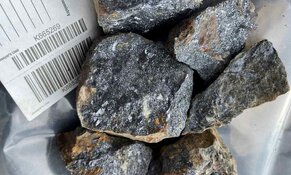David Morgan: My fascination really started as a teenager, particularly with the stock market and money. Once I started researching money, I found out that a stable monetary base usually requires the backing of precious metals. But that was just the beginning. What really got me motivated about the silver market was the first bull market that I was involved in through the 1970s into 1980. I wasn't that big a silver bull at that time. I was more of a gold bull, but silver outperformed gold at the end of the market cycle so substantially that I started to study silver more diligently. I wanted to know why.
The Hunt brothers were big investors in the silver market throughout the 1970s. Everyone explained the silver boom with "it's the Hunts," but I wanted to know why the Hunts put that much money into silver. Why didn't they buy gold? What fascinated the Hunts about the silver market? Once I dug deeper, there were significant factors outside the Hunt brothers that made silver a compelling study.
TGR: What made you launch your newsletter?
DM: I had read almost everybody in the industry in my 20s and 30s, and I found most of them to be of little use. They were providing very little useful information and most did not reply to their members' questions. And most of them had their particular "penny" mining stock that they were touting. I learned a lesson the hard way—more money than I should have into a lot of junior mining companies. I ended up losing money. You couldn't really sell those juniors unless you were selling going into the top of the market.
Our publication strives to balance risk and reward; we look at money, metals and mining. We were the first to write about rare earths, for example. Certainly, I am known as a "silver" guy; but we report on much more than just silver. My premise was that serious money would go into "serious" companies and "play money" would go to the "play" companies.
I thought my experience would benefit anyone who was serious about this sector. We have had junior mining companies that did poorly; but, if you follow the rules and you spread them out in a basket, you're going to do well. If you have 90% of your capital allocated into the top-tier, cash-rich, unhedged mining companies that I outline in every report, you've definitely made money. Is everyone a winner? No. There's no one who's honest that I know who benefits their readers with every pick they make.
TGR: In May you told The Gold Report that silver would reach a new nominal high in December 2010 of $21. It's just under $20 now. Do you still think you will be proven correct? Or do you think you're somewhat conservative in your forecast?
DM: Well, $21 is probably a little conservative. Earlier in the year, I think I said $25, but I am not sure we will get there; but I think I can safely say between $21 and $25. I believe we're seeing quite a bit of interest in the metals now that hasn't been there before.
Keeping my sources confidential, I have had a couple of calls from people in Washington, D.C., and a few from overseas, and they've woken up to the silver story. Before now, they were gold-only or gold-centric people. There's some relatively big money moving into the silver market, and because silver is such a small market relative to gold, it won't take much new money to move it substantially.
TGR: With that in mind, Sprott Asset Management's John Embry recently said gold would never go below $1,000 an ounce again. Are you willing to establish a similar floor for silver?
DM: Yes, it will not go under $1 for the rest of my life.
TGR: Would you be willing to raise that floor?
DM: It's too early to say $20; $15 may work. I believe there will be a time when $20 will probably become the floor, but it's not there yet.
TGR: We are now in a secular bull market for silver and gold. If you were to peg that run on a calendar, where would we be—May, June?
DM: Oh, probably July or so. What people don't understand is how markets move. I've gone all around the world stating that 90% of market movement is during the last 10% of the time. That's probably an exaggeration; it isn't exactly true, but the idea is very correct. The big part of the move comes in the panicked, frenzied buying at the top of the market like what happened in the tech wreck or the housing bubble. Moving markets like those get a lot of people excited in a very short time. That's where you don't want to let greed take over; you want to stay cool, calm and collected because you want to be able to take profits by selling into strength.
You also want to be logical; you have to know that you're not going to sell at the exact top. To think you can sell at the exact top is an amateur's game. If you're a professional investor, you leave some money on the table for the next buyer because once you've hit the top, you can't get out easily. There will be so many sellers that it will crash the market. I suggest your readers verify this for themselves—look what happened to the NASDAQ or the real estate market.
Knowing this information ahead of time means you can anticipate the market. My readers know I went through the major bull market the last time, so I am very prepared to help them be successful with this one. Go back to the ultimate high (in real terms) on January 21, 1980. Gold was about $300 on December 1, 1979, but what happened? People lost their heads; they had to own gold for whatever reason and the panic/greed buying took place. I was in the futures market at $300 gold, which was a new high. But you were able to get out a few weeks later at $600 on a futures contract. I was making more money per day than I was per month at my job. Those were exciting times, especially when you're in your 20s.
What I am pointing out is the way these markets move; many people who were in this market have left and they won't come back until it's getting near the end. In other words, when we're getting into "panic buying" mode. There will be very few people like me who have a core position that they're riding all the way up. I trade around the main trend, as well for short-term profits, while maintaining my core position.
But the answer to the question is we're in July probably, but you really want to be in the market in December. You want to be in December, and that's a metaphor for the time. What we talked about before that big move in the last 10% of the time. But be careful don't stay too long.
TGR: But how you do you get people to remain calm?
DM: I don't; I can't. I am always preparing myself for the hate mail and phone calls. When I put a sell signal out on some of these stocks, for example, I'll get mail from some of my most ardent fans. They say things like: "Have you lost your mind?" "What are you smoking?" "Are you taking drugs?" "Are you getting paid off?" This goes on and on. The simple fact is I'm not a pig. Bulls make money, bears make money and pigs get stuck. I 'm not going to get stuck, and neither are you if you follow what I'm doing.
TGR: That was great. The rise in the silver price is largely responsible for the growth of the pure silver plays out there, but are there other factors that are somewhat less obvious?
DM: First of all, there really aren't any pure silver plays. Hardly any silver mine is silver alone; it's silver and lead, or silver and zinc, or silver and copper or silver and gold. There are a few that are very close, though. You have to be a little bit careful about anything with silver in its name.
Anyway, back on point, no, I don't believe so. Silver miners are basically tied to the silver price whether they like it or not. Now, having said that, there is a case for pure economics. What I mean by that is I don't care what kind of "widget" you're producing. If your widget happens to be silver and you can mine it for a profit and the margin is so high that you can make a profit at $10 per ounce of silver, for example, then obviously that particular miner certainly cares about the price. But they also have a viable business for a very long time, regardless of the price, that many others may not enjoy
TGR: Last time you spoke with us you said you had bought even more shares of First Majestic Silver Corp. (TSX:FR; OTCQX:FRMSF). Are you still buying and what's happening with that company?
DM: Well, First Majestic continues to do what they had projected for a very long time. It's a very leveraged silver company. It's mining silver; there are a very few byproducts. They've finally met their financial objectives as far as the amount of money they said they were going to make on a quarterly basis. Keith Neumeyer once had great success with a copper company. You choose these companies based on a lot of factors, and management is certainly one of the factors. Someone who's done it before is more likely to do it again than someone who's never done it.
TGR: Which company did Keith have success with?
DM: It was First Quantum Minerals Ltd. (TSX:FM). I have stopped buying First Majestic, but I certainly think it is one of the best in what I'll call the midtier sector. We did a special report on it, for our members only, and we still like the company.
TGR: Are there any catalysts for growth with First Majestic?
DM: Yes, and that is outlined in our special report. As things continue, you really should discover for yourself what the dynamics are. It has a good growth profile for a few years.
TGR: Could you at least share the target price on that?
DM: I don't have a target price. The problem with a target price is if that if the company doesn't make your target price, then people are upset with you. If it goes past your target price, people are upset with you. It's a no-win position. I don't like to give target prices. I usually say, "this looks like it's topping out here," and tell people to lighten up. Targets are really a disservice to investors; it takes the thinking out of it.
But let me share a bit about target prices. The way you get a target price is a PE, the price to earnings multiple. You can make your own targets. At the top of the market, a silver company that's mining silver—not just some kind of moose pasture with the name silver involved—will sell at 50 times earnings. Now, that's the top of the market. Right now, we've got some that are selling at 10 times earnings. You take that 10-times-earnings company, multiply its current price by 5 and come up with a target. That's a safe and sound way of doing it. Is it guaranteed to reach that price? What would it be like if I could predict the silver market with 100% accuracy?
TGR: You also talked about Silvermex Resources Ltd. (TSX.V:SMR) in your last interview with us. In fact, you said: "I like the company, but I think it will stay within the pack." Is the stock performing as expected, and what can we expect from the junior in the year ahead?
DM: It's not performing as expected; I was one of the first ones on the company when it first began trading and many of my subscribers at that time were profitable in the stock. As the debt crisis of 2008 hit, we were stopped out of the company. Now it looks like they're serious about moving this project toward production. Art Brown, whom I know well from his Hecla Mining Co. (NYSE:HL) days, is becoming very involved. Given the management team, I would expect that they would be doing better than they are now, but again, it's a speculative situation. I mean you can't really compare a company that's a non-producer to a producer. They're two different animals. It's much more difficult to get a mine into production than almost any other business you can think of. Just because they're planning to put it into production does not guarantee that they will—now, I believe strongly that they will—but the market is basically saying, "show me; don't tell me." In other words, it's not performing as strongly as I'd like, but I still own it.
TGR: Are there catalysts that could take it to the next level?
DM: Well, I used to think I could beat the market by knowing the price to projected earnings, and all the stuff we talked about a moment ago, and certainly that plays into it. But markets are psychological. If people decide that Silvermex is the coolest name you could have for a silver company, that will move the stock. I am being serious. If some fund manager puts a lot of money in it because he feels it's undervalued, that will move the price of any stock. There are lots of factors. The primary one, like any stock, is earnings. Stocks move on earnings when they are real companies. Big profits equal big gains in the stock market almost every time. Imagine that—amazingly simple!
TGR: What are some other companies that you're bullish on?
DM: Most of the silver companies are in Mexico. For example, SilverCrest Mines Inc. (TSX.V:SVL), Great Panther Silver Ltd. (TSX:GPR) and several others. If you compare the numbers of Great Panther to First Majestic, I think you'd find them favorable. We've written about that company for our members. SilverCrest is a producer with high gold value. I own Great Panther; I own SilverCrest. I own First Majestic.
Then you have a discovery situation like Esperanza Resources (TSX.V:EPZ). I think that if things continue in the same direction, Esperanza could be a takeover target.
But there is a bit of a problem with all of these companies: they're all in Mexico. I like to tell people to be diversified, which means you not only diversify throughout your silver holdings, but you diversify your silver holdings geopolitically.
I am not saying anything's wrong with Mexico, but subscribers continually ask about the drug wars and will it have an impact of some of these companies and the truth is it can.
My caution is caveat emptor—buyer beware. The due diligence I do is good, but it's not perfect. You could consider the work that we do here to be a huge timesaver to serious investors, but it is always best to do any further research or study before investing. In other words, you might want to do further due diligence and if you determine the current climate in Mexico to be too risky, then so be it.
TGR: But companies like SilverCrest have other properties. For example, SilverCrest has the El Zapote silver-zinc project in El Salvador. I wouldn't say that El Salvador is any safer than Mexico, but it's not Mexico.
DM: You are correct; many companies have projects in several countries. Take Silver Standard Resources Inc. (TSX:SSO; NASDAQ:SSRI) as an example; they've got projects all over the world, so that one stock is diversified. If something went wrong with their projects in Mexico, they have projects elsewhere that would lessen the problem. But if you have a company that's only in Mexico, and drug-related activity escalates in Mexico, that might affect the stock price.
It would be a disservice to your readers to ignore it and say Mexico is the greatest silver place to invest in that you possibly can, when I know full well that there are some issues going on down there.
TGR: Yes, but I think you're painting a distorted picture. These companies have producing assets in Mexico, but they also have significant mining projects in other countries. Esperanza has a project in Peru, and as I mentioned SilverCrest has one in El Salvador. There is some diversification within those companies.
DM: That's what you want. When you choose an investment in the resource sector, you want to be spread out in a reasonable way. But if you've got a project that's an all-or-nothing bet, then you want to consider very carefully that it has a higher risk.
Let's use Mines Management, Inc. (TSX:MGT; NYSE:MGN) as an example; it has a project in Montana, pure and simple. There is no back-up plan. That means it's a much higher risk than it would be if they had three other projects in other locations, even though it's in the U.S. The U.S. has issues. I mean it's harder to get a project approved in Montana than, say, in Nevada. Nevertheless, I truly believe that it will have a mine in Montana.
TGR: Could you leave us with some comments on the silver sector?
DM: Silver is under-recognized, misunderstood and still has great upside potential. In my January 2009 issue of The Morgan Report, I said that gold would become mainstream by the end of the year, and I was right. Once gold hit $1,000, gold became a kind of fashion hub of the investment community, even on Wall Street. Everyone was talking about gold, day after day, and no one was even whispering the word silver.
I think you will see silver in the mainstream news in 2011. I've certainly been swamped with calls from large moneyed entities that have never considered silver before. That's kind of new; I mean it happened once before when silver bottomed in 2008. I had a plethora of consultations with high-end people who were savvy enough to pretty much buy at the bottom of the market. We're seeing those dynamics again now.
TGR: David, this has been great. We appreciate your insights.
David Morgan (Silver-Investor.com) is a widely recognized analyst in the precious metals industry and consults for hedge funds, high net worth investors, mining companies, depositories and bullion dealers. He is the publisher of The Morgan Report on precious metals, author of Get the Skinny on Silver Investing (Morgan James Publishing, 2009), and featured speaker at investment conferences in North America, Europe and Asia.
Want to read more exclusive Gold Report interviews like this? Sign up for our free e-newsletter, and you'll learn when new articles have been published. To see a list of recent interviews with industry analysts and commentators, visit our Expert Insights page.
DISCLOSURE:
1) Brian Sylvester of The Gold Report conducted this interview. He personally and/or his family own shares of the following companies mentioned in this interview: None.
2) The following companies mentioned in the interview are sponsors of The Gold Report: First Majestic, Silvermex, Esperanza, SilverCrest and Great Panther.
3) David Morgan: I personally and/or my family own shares of the following companies mentioned in this interview: First Majestic, SilverCrest, Great Panther. I personally and/or my family am paid by the following companies mentioned in this interview: None. The Silver Investor does accept payment from companies for republishing rights and email distribution to the free email list.









































